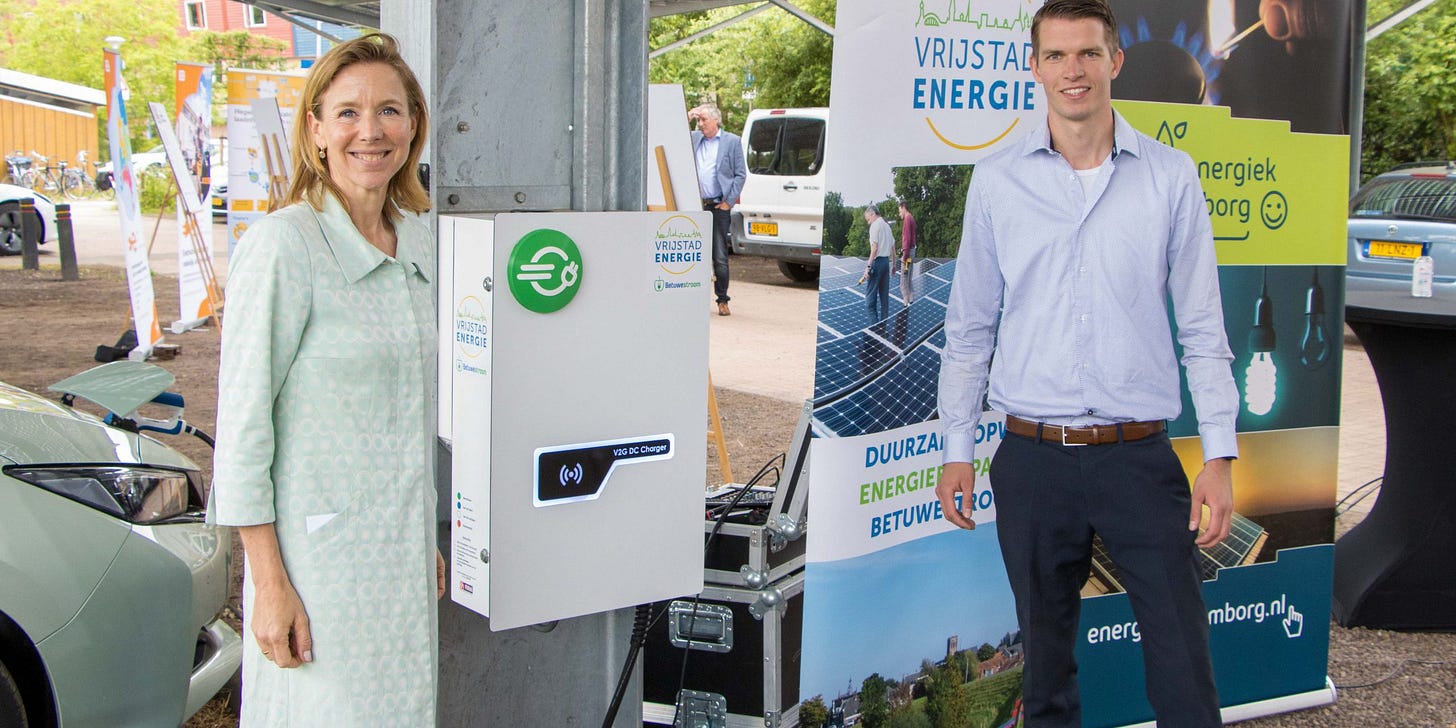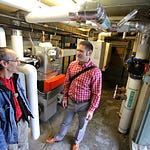Dear reader,
Imagine a future in which we’ve moved decisively to sustainable energy sources and not only that – imagine that that transformation was managed and owned to a large extent by citizens, banded together in cooperatives, foundations and not-for-profit companies. How would that transition have happened?
To answer (parts of) that question, I talked to geographers Emma Folmer (University of Groningen) and Benedikt – or Ben, for Social Life of Energy readers – Schmid (University of Freiburg). They used their research into community-based and community-oriented initiatives to jointly tackle the question: is systemic change possible, through the many thousands of citizens’ seemingly “small” and “local” blooming flowers?
This question thus marks a shift in this series on social entrepreneurship in sustainable energy: from a discussion mostly of properly commercial companies to straight-up community initiatives – or what Emma calls “collective entrepreneurship”. Here are the main points you’ll find in this edition:
Social enterprises are little engines of innovation
Governments can foster this innovation in small and (cost-) effective ways
An engineering-type perspective on scale and efficiency has fundamental laws
Collective entrepreneurship can be a constitutive part of a vital democracy
Curious? Read on for the executive summary (and read more in the transcript), or tune in to the full interview by clicking on the play button on the top of this email or by firing up The Social Life of Energy in your favourite podcasting app!
Off-the-grid homes and on-the-grid vehicles
What needs to happen for systemic change? Well, two things at least: replication (or “roll-out” – but we’ll get to that) and institutional change that can accommodate new ways of doing things. Let’s start with the latter. What does that look like in the case of community enterprise – and what does its absence look like?
Among the 24 initiatives in and around Stuttgart that Ben talked to for his PhD research, there was a group of people who wanted to build off-the-grid (tiny-esque) homes. Off-the-grid means self-sufficient and that includes (potable and waste) water. However, homes in Germany are required to link to up the sewage system, and if somehow you want to organize your own drinking water, you need to get certifications that your water is actually safe. Getting the approval to delink, and obtaining the certification for potable water proved tricky. First of all, the group needed to work with several authorities with overlapping jurisdictions. And while they actually did have supporters in local government, others couldn’t care less about the project. Meanwhile, despite their support, administrators had to work with an ambiguous legal framework and they were hesitant to make executive decisions in that gray space.

OK, so from this super brief case study, let’s take stock for a sec. You have a couple of people trying to do new things that don’t fit any established categories – you know, innovation. In part, “not fitting” means there is literally no category for it: say, “off-the-grid” living. But it also means there is no process for it: the existing authorities and their jurisdictions were erected in and for another world. Attempts to re-make that world require new (regulatory) cooperation to survive.
For an example of how that might go, let’s turn to Emma’s main example.
It revolves around a cooperative community in the Netherlands that had installed rooftop solar panels on a parking lot. That process had gone fairly smoothly so they set their sights on something higher: to turn the parking lot into a EV charging station. That went much less smoothly. Same story: different state authorities, which were initially hesitant to give the green light, because of the same kind of regulatory uncertainty. But then a break: the national government launched a subsidy program for precisely these sort of EV charging car parks, which emboldened the municipality to take the plunge. To their credit too, they immediately addressed the problem of multiple jurisdictions by appointing a sort of case manager who acted as the main interlocutor for the initiative and others like it.
Now: what do these examples say about accommodation through institutional change?
Institutional change – cross-sectoral collaboration?
Maybe it’s good to first note that this sort of accommodation is different from the co-creation we saw last week: the collaborative networks assembled for the sake of larger infrastructural projects. Instead, the process of change is initiated by groups who are trying to make something they believe in financially viable. Viable, not necessarily profitable in any conventional sense. Hence, there is also no imperative to grow, as in many conventional markets. The bottom-line is just that: a foundation to stand on, not an horizon to chase. Finally, people do this mostly on the side, not as professionals. So, it’s understandable that governments are unsure about how to work with them.

The municipality’s choice to appoint a specialized contact person is therefore a valuable move because 1) it creates an interface at which different state institutions can learn to work together, and 2) it simplifies things considerably for citizens. That kind of simplification that can go a very long way. (That being said, the EV charger initiative actually also designated their own contact point, someone who could go to night school to learn Bureaucracy. (Also a good idea.)
The efficiency of scale – but what efficiency?
For a meta-twist in the story, though, Emma mentioned she also talked to a commercial provider of EV-charging stations about this case. While the representative was sympathetic to the initiative, he also ultimately dismissed its significance given the magnitude of our collective challenge to decarbonize mobility. What we need, according to him, was an actor with the financial and logistical wherewithal to roll out an EV-charging grid over the whole country. It’s just more efficient.
Let’s call this the central planning perspective: it allows you to see society as a machine, and landscapes as a flow-chart. While in the right hands perhaps a useful point of orientation, if you don’t realize its limits, you’re in for some nasty IRL surprises. With wind, we’ve seen that trying to roll out ‘efficiently and at scale’ is actually quite inefficient, because it doesn’t create space for self-determination and thus generates its own opposition. Projects strand. Efficiency null.

But the question of efficiency is bigger than that. What do we really call efficient? Co-creation with and by citizens – admittedly in its best cases – can produce solutions that synergize with other planning challenges that both local governments and citizens can bring to the fore. An “efficient” roll-out of central plans would completely miss such efficiencies at lower ‘scales’ though, because they’re simply invisible at higher scales.
The question of efficiency is also deeper. Both Ben and Emma emphasize that community undertakings generate more than the product, service or piece of material infrastructure they were called into being for. Emma:
it also creates people's understanding of the problem, their willingness to invest in changing their behaviour. It helps people be part of a change, to enhance their sense of self-efficacy, to be part of the energy transition – that's also democratizing. That is a social value in itself.
That’s a lot of output for relatively little government input. However, we haven’t found good ways of measuring such value and so it’s easy to remain out of sight. That’s why we should be having more conversations about how valuable it is – and re-evaluate how much value conventional markets generate.
Oh and actually, what scale?
Ben remarked that we’re easily fooled by the small scale of the individual initiative. It looks insignificant. But these initiatives are not alone. Ben:
Communities are doing a lot of similar things in a lot of different places. That's also a form of scaling: there’s a kind of congruence – and they don't even necessarily have to be connected or networked.
It may be a quiet revolution. And we can hasten it by encouraging interconnections and replications. Among his 24 case-studies, Ben already saw a lot of cooperation and exchange taking place. Governments can help these initiatives by creating and fostering platforms for collaboration.
Complexity and learning
This is in fact the main message I take away from our conversation: policy makers and civil servants should treat this amorphous field of community enterprise as one giant laboratory of innovation. As Emma pointed out, it’s just like with ordinary entrepreneurs: “For every successful enterprise that you see there have been X number of failed enterprises going before it.” After much experimentation, someone finds the magic formula. So:
If you equip these groups of people with information, with know-how, with self-efficacy, this empowers people on a local level, right? To create change, even if small. But if we have many, many changemakers, together, connected and cumulatively, they will definitely help us forward.
And as Mariana Mazzucato has shown: the state is (or rather: can be) the entrepreneurial entity par excellence. And I guess that works with billion Eurodollar strategic investments as much as with small helping and guiding hands.
How, exactly? While I’d love to answer that question, I’ve gone on for too long already 😬. But please talk to Emma (LinkedIn) and Ben (Twitter) about it. In one sentence though: create space for experimentation (like ‘sandboxes’), promote learning networks, support in small financial ways, and find the courage to chart one’s own path in unknown legal seas.
That’s all folks. You can keep up to date about Emma’s work through the CREDS’ project Social Entrepreneurship at the Grid’s Edge, and you can read all about Ben’s work in his book Making Transformative Geographies.
That’s also it for 2021, see you in the next year!
Happy holidays and take care 👋,
Marten












Share this post